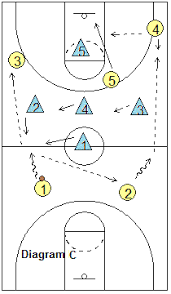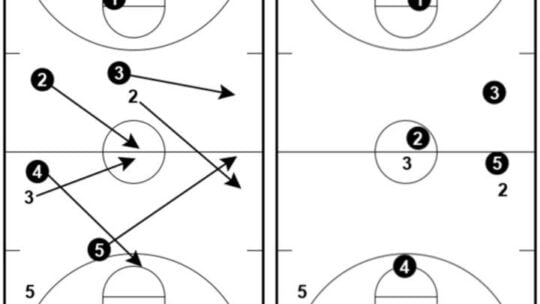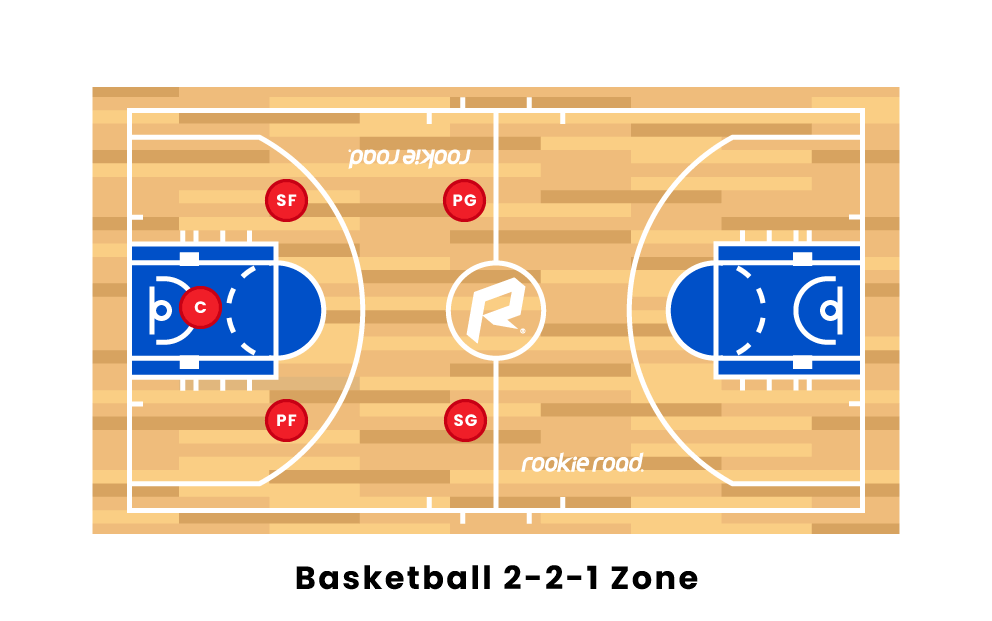Basketball Strategies for Breaking the Half Court Press
You can find basketball strategies for breaking any form of the half-court press if you do a little searching online – you can find press offenses designed to break half-court presses set up in formations of 1-2-2, 2-1-2, 1-2-1-1, and plenty more.
But frankly, I don’t have the practice time available to teach a variety of half-court press offenses and still be able to teach everything else my team needs to know to improve and have a successful season.
So I teach a basic half-court press offense (vs 1-3-1 press) and then teach my team how to adjust to a variety of setups.
Half Court Press Breaker Tips
I teach specifically a press break against a 1-3-1 press because I think that is the most common formation for the half-court press.
Most zone presses starting at half-court rely on directing the ball to the half-court corner and trapping the ball carrier there, which means the defense will have one guard out front to do the directing.
Even presses that are designed with two guards at the top generally have one of the guards directing the ball, with the other protection against the ball reversal to the second offensive guard.
So if my players understand basketball strategies for breaking a 1-3-1 half-court press, I feel they have a good base to work from and any additional strategies we add can stem naturally from this base.
So, a few guidelines I try to instill in my players for half-court press breaks, regardless of the press being put against them:
Half Court Press Break Rules
- Reverse the ball before the trap (possibly more than once as we come up the floor) – the more we force the defense to shift their attack, the more likely that one or two of their players will leave a gap we can exploit.
- Keep the floor spread – don’t have two players so close to each other that one defensive player can guard them.
- Have a man deep – this will spread the defense more (if you don’t have that man deep, the defense can cheat easier and clog up passing lanes).
- Move quickly to the open spot.
- Always look to attack.
The Focus of the Half-Court Press Offense
In general, the focus of the attack on any half-court press is to:
- Look to pass into the middle or down the sideline as the trap is being sprung – but before the trap closes on the ball carrier. (Alternatively, a quick reversal and pass into the middle/sideline before the defense can react.)
- Once the pass to the middle/sideline happens, there should be at least two players cutting to the hoop on the attack.
Although you can diagram as much as you want, you need to teach your players to adapt to and act on whatever the defense gives them. Since pretty much every zone press I know of relies on that trap, then someone must be open somewhere. Find the open man and move quickly to capitalize on the resulting defensive adjustments.
What I tend to do is throw some different situations at my players in practice and let them adjust as necessary, stopping the practice to explain where they might find openings and offer basketball strategies they could use to capitalize on them.
But again, I don’t have the practice time available to teach a multitude of press breaks, and I don’t think that would be the best way to develop my players anyway. In the end, we want them to develop the ability to read the situation and react appropriately.
Here are a few situations you could use in practice:
Press Break Against a 1-2-2 Half-Court Press
As the trap begins to materialize, #1 reverses the ball to #2. Immediately (and they should be reading this and expecting it), the other players cut hard to the new ball side – #3 to the sideline, #4 to the middle, #5 and to the sideline across from the foul line.
Immediately after the reversal, #2 looks to pass the ball into 3 on the sideline or #4 in the middle, whichever is left open as the defense shifts. In this example, w,e have the ball going to #3 on the sideline.
Immediately we attack. #1 cuts hard on the weak side straight to the hoop. #3 looks to pass down to #5 or to #4 in the middle. Possibly to #1 on the weak side. But essentially, we look to get the ball first to someone in a good passing position (the middle would be best as it opens up both sides of the floor), and then to a player cutting hard to the hoop.
Press Break Against a 2-2-1 Half-Courtress
Against a 2-guard front, the second guard makes the reversal difficult – although you could, and should, reverse the ball once or twice as you approach the press.
But with the second guard so high in the formation, the middle or sideline should open up easier once the defense moves to trap. If your players are spread well, and your ball carrier is composed and alert, a quick pass to whichever player opens up should be available.
In this example, the pass goes down the sideline to #4.
Once the pass is made out of the trap, immediately attack the hoop. With the ball on the sideline, #3 cuts hard to the top of the key, #5 cuts to the sideline, and #2 and ts down the weak side. Again, we take advantage of the defense as they struggle to fall back and attack quickly.
If it is the middle that opens up from the trap, we get the ball there – to #3 in this example. From here, #3 can lead the play into the hoop with other players cutting to the open lanes.
Again, these are just situations to throw at your players to get them thinking. The main focus of practicing press breaks is really on taking away the strangeness of the press – i.e., if your players are accustomed to pressure and are prepared to look for openings when it happens in the game they will be less likely to be hurt by it.
There are a variety of basketball strategies for breaking presses; I try not to overload my players with too many plays. I would rather help them understand basic movement and how to attack, and then let them take advantage of what the defense offers.




